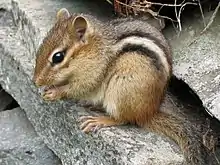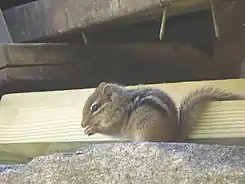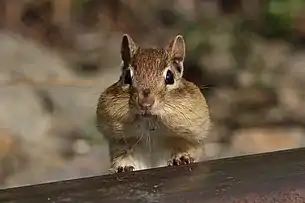Eastern chipmunk
The eastern chipmunk (Tamias striatus) is a chipmunk species found in eastern North America. It is the only living member of the chipmunk subgenus Tamias, sometimes recognized as a separate genus.[2] The name "chipmunk" comes from the Ojibwe word ajidamoo (or possibly ajidamoonh, the same word in the Ottawa dialect of Ojibwe), which translates literally as "one who descends trees headlong."[3]
| Eastern chipmunk | |
|---|---|
 | |
| Scientific classification | |
| Kingdom: | Animalia |
| Phylum: | Chordata |
| Class: | Mammalia |
| Order: | Rodentia |
| Family: | Sciuridae |
| Genus: | Tamias |
| Species: | T. striatus |
| Binomial name | |
| Tamias striatus | |
| Subspecies[2] | |
| |
 | |
| Synonyms | |
|
Sciurus striatus Linnaeus, 1758 | |
Description
A small species, it reaches about 30 cm (12 in) in length including the tail, and a weight of 66–150 g (2.3–5.3 oz).[4] It has reddish-brown fur on its upper body and five dark brown stripes contrasting with light brown stripes along its back, ending in a dark tail. It has lighter fur on the lower part of its body. It has a tawny stripe that runs from its whiskers to below its ears, and light stripes over its eyes. It has two fewer teeth than other chipmunks and four toes each on the front legs, but five on the hind legs.[5]
Habitat
The eastern chipmunk lives in deciduous wooded areas and urban parks throughout the eastern United States and southern Canada. It prefers locations with rocky areas, brush or log piles, and shrubs to provide cover.
Behavior
It can climb trees well, but constructs underground nests with extensive tunnel systems, often with several entrances. To hide the construction of its burrow, the eastern chipmunk carries soil to a different location in its cheek pouches. It also lines the burrow with leaves, rocks, sticks, and other material, making it even harder to see.[6] It has several bird-like or chattering calls; one is a trill at the rate of 130 vibrations per minute and another is a lower-pitched, clicking sound.[5]
Diet

It is mainly active during the day, spending most of its day foraging. It prefers bulbs, seeds, fruits, nuts, green plants, mushrooms, insects, worms, and bird eggs. Like other chipmunks, it transports food in pouches in its cheeks.
Lifecycle
The eastern chipmunk defends its burrow and lives a solitary life, except during mating season. Females usually produce one or two litters of three to five young.[5] The two breeding seasons are from February to April and from June to August. During the winter, the chipmunk may enter long periods of torpor, but does not truly hibernate.[7]
Predators of the eastern chipmunk include hawks, owls, foxes, raccoons, snakes, weasels, coyotes, bobcats, lynx, domestic dogs and domestic cats. On average, eastern chipmunks live three or more years in the wild, but in captivity they may live as long as eight years.[5]
Eastern chipmunks are known to be one of many hosts for the parasitic larvae of Cuterebra botflies. [8]
T. s. doorsiensis
The subspecies Tamias striatus doorsiensis was described in 1971.[9][10] It is only found in Door, Kewaunee, northeastern Brown, and possibly Manitowoc counties in northeastern Wisconsin.[11] Compared to the other subspecies of eastern chipmunk present in nearby in Michigan and Wisconsin, they have brighter patches behind their ears, grayer hair along their backs, and more white on their tails.[12] It is smaller than T. s. griseus but larger than the least chipmunk (Neotamias minimus).[11]
Gallery
 Eastern chipmunk with filled cheek pouches, Cap Tourmente National Wildlife Area, Quebec, Canada
Eastern chipmunk with filled cheek pouches, Cap Tourmente National Wildlife Area, Quebec, Canada_-_Guelph_04.jpg.webp) Looking to the left
Looking to the left_-_Guelph_02.jpg.webp) Facing downwards
Facing downwards Chipmunk in Ohio, U.S.A.
Chipmunk in Ohio, U.S.A.
References
- Linzey, A. V.; NatureServe (2008). "Tamias striatus". IUCN Red List of Threatened Species. 2008. Retrieved 25 November 2010.
- Thorington, R.W., Jr.; Hoffman, R.S. (2005). "Tamias (Tamias) striatus". In Wilson, D.E.; Reeder, D.M (eds.). Mammal Species of the World: A Taxonomic and Geographic Reference (3rd ed.). Johns Hopkins University Press. p. 817. ISBN 978-0-8018-8221-0. OCLC 62265494.
- Chipmunk, Online Etymology Dictionary
- "Archived copy". Archived from the original on 3 December 2013. Retrieved 26 November 2013.CS1 maint: archived copy as title (link)
- Eastern Chipmunk Archived 8 July 2011 at the Wayback Machine, West Virginia Wildlife Series
- Chipmunks, Institute of Agriculture and Natural Resources, University of Nebraska. p.B-14.
- The mother of all hangovers Archived 26 April 2012 at the Wayback Machine, McGill University WARM SPARK
- Paquette, Chelsey; Garant, Dany; Savage, Jade; Réale, Denis; Bergeron, Patrick (May 2020). "Individual and environmental determinants of Cuterebra bot fly parasitism in the eastern chipmunk (Tamias striatus)". Oecologia. 193: 359–370.
- ITIS Report for Tamias striatus doorsiensis, accessed 10 September 2019
- Long, C.A. (2008). The Wild Mammals of Wisconsin. Pensoft Series Faunistica. Coronet Books Incorporated. p. 181. ISBN 978-954-642-313-9. Retrieved 10 September 2019.
- Tales of the wild: a year with nature by Roy Lukes, (entry on worldcat.org) Egg Harbor, Wisconsin: Nature-Wise, 2000, p. 73
- Thorington, Richard W., Jr.; Koprowski, John L.; Steele, Michael A.; Whatton, James F. (2012). Squirrels of the World. Johns Hopkins University Press. p. 354. ISBN 9781421404691. Retrieved 10 September 2019.
External links
 Media related to Tamias striatus at Wikimedia Commons
Media related to Tamias striatus at Wikimedia Commons Data related to Tamias striatus at Wikispecies
Data related to Tamias striatus at Wikispecies- Earthwatch. "Eastern Chipmunk Tamias striatus". Encyclopedia of Life Field Guides. Archived from the original on 1 January 2016. Retrieved 7 December 2012.
- Eastern Chipmunk, Fletcher Wildlife Garden

